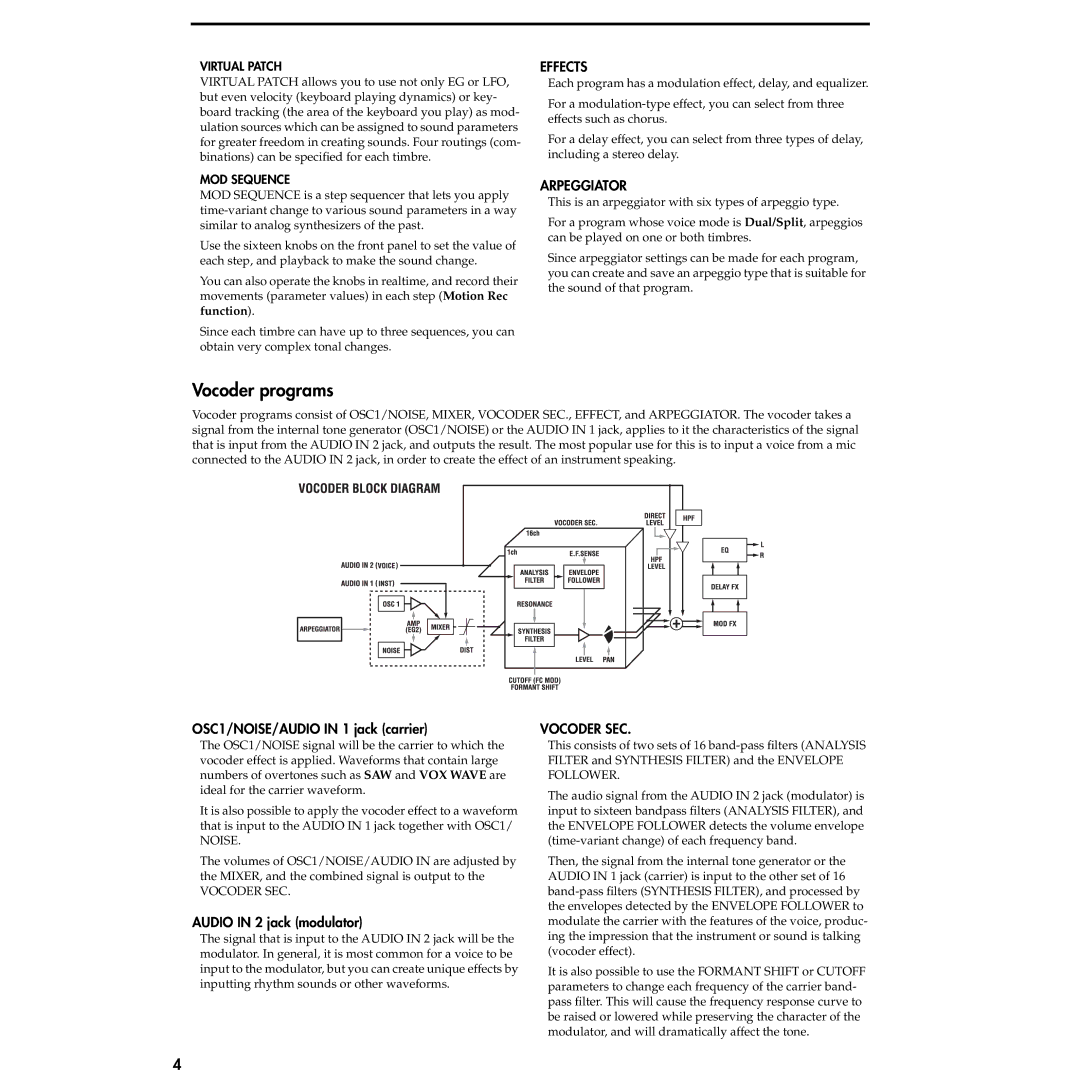
VIRTUAL PATCH
VIRTUAL PATCH allows you to use not only EG or LFO, but even velocity (keyboard playing dynamics) or key- board tracking (the area of the keyboard you play) as mod- ulation sources which can be assigned to sound parameters for greater freedom in creating sounds. Four routings (com- binations) can be specified for each timbre.
MOD SEQUENCE
MOD SEQUENCE is a step sequencer that lets you apply
Use the sixteen knobs on the front panel to set the value of each step, and playback to make the sound change.
You can also operate the knobs in realtime, and record their movements (parameter values) in each step (Motion Rec function).
Since each timbre can have up to three sequences, you can obtain very complex tonal changes.
Vocoder programs
EFFECTS
Each program has a modulation effect, delay, and equalizer.
For a
For a delay effect, you can select from three types of delay, including a stereo delay.
ARPEGGIATOR
This is an arpeggiator with six types of arpeggio type.
For a program whose voice mode is Dual/Split, arpeggios can be played on one or both timbres.
Since arpeggiator settings can be made for each program, you can create and save an arpeggio type that is suitable for the sound of that program.
Vocoder programs consist of OSC1/NOISE, MIXER, VOCODER SEC., EFFECT, and ARPEGGIATOR. The vocoder takes a signal from the internal tone generator (OSC1/NOISE) or the AUDIO IN 1 jack, applies to it the characteristics of the signal that is input from the AUDIO IN 2 jack, and outputs the result. The most popular use for this is to input a voice from a mic connected to the AUDIO IN 2 jack, in order to create the effect of an instrument speaking.
OSC1/NOISE/AUDIO IN 1 jack (carrier)
The OSC1/NOISE signal will be the carrier to which the vocoder effect is applied. Waveforms that contain large numbers of overtones such as SAW and VOX WAVE are ideal for the carrier waveform.
It is also possible to apply the vocoder effect to a waveform that is input to the AUDIO IN 1 jack together with OSC1/
NOISE.
The volumes of OSC1/NOISE/AUDIO IN are adjusted by the MIXER, and the combined signal is output to the
VOCODER SEC.
AUDIO IN 2 jack (modulator)
The signal that is input to the AUDIO IN 2 jack will be the modulator. In general, it is most common for a voice to be input to the modulator, but you can create unique effects by inputting rhythm sounds or other waveforms.
VOCODER SEC.
This consists of two sets of 16
The audio signal from the AUDIO IN 2 jack (modulator) is input to sixteen bandpass filters (ANALYSIS FILTER), and the ENVELOPE FOLLOWER detects the volume envelope
Then, the signal from the internal tone generator or the AUDIO IN 1 jack (carrier) is input to the other set of 16
It is also possible to use the FORMANT SHIFT or CUTOFF parameters to change each frequency of the carrier band- pass filter. This will cause the frequency response curve to be raised or lowered while preserving the character of the modulator, and will dramatically affect the tone.
4
